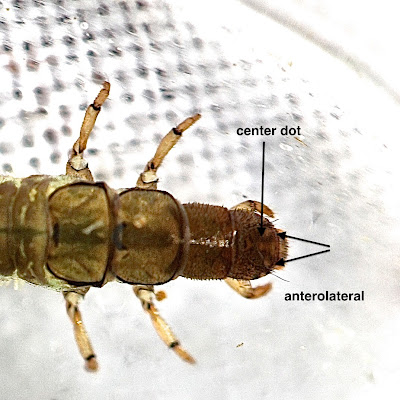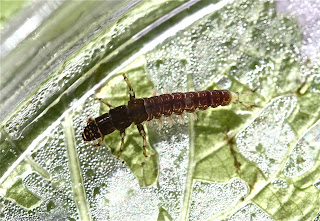Thursday, July 4, 2013
It's also common netspinner time: up to the Moormans
We've had 3 inches of rainfall in C'ville since Tuesday. So, when I left home this morning I told my wife that I was off to the Doyles River -- and once I had seen how high and muddy it was I'd go up to the Moormans -- and once I had seen how high and muddy it was, I'd be home. The Doyles and the Moormans -- 30 minutes off to the west -- were fine. Go figure!
I decided to look in the Moormans in Sugar Hollow below the first bridge expecting to see large numbers of small minnow mayflies. I did see a few, and a lot of E. vitreus flatheaded mayflies. But I was struck by the number of common netspinners there were on the rocks, all different colors.
As it turned out, I had picked up three different species -- Ceratopsyche bronta (in the photo above), Ceratopsyche sparna, and Hydropsyche betteni. I know that C. morosa lives in here as well -- but I didn't see any today.
Ceratopsyche bronta.
This is one of the more colorful netspinners we see with the various stripes and spots on the head and the nota, all visible to the naked eye -- no loupe is required. Beaty describes this one in the following way: "head with 3 distinct transverse stripes with central stripe expanded mesally and often with light spot in middle; nota with anterior and posterior transverse dark bands." (Beaty, "The Trichoptera of North Carolina," p. 73)
The dark bands on the nota are clear in the photo above. Here's a closer look at the head where the stripes and light spot can easily be seen.
Tolerance value: 2.3
________________
Ceratopsyche sparna.
Lots of C. sparnas.
This one is also pretty easy to see -- well, when you've seen as many as I have. The body is light in color; the head golden brown, and you can see light colored spots on the head. The description I use for this one is in Schuster and Etnier ("A Manual for the Identification of the Larvae of the Caddisfly Genera Hydropsyche pictet and Symphitopsyche Ulmer in Eastern and Central North America," 1978). Their description of C. sparna (they call it Symphitopsyche sparna), is on p. 52.
"Head, nota and all leg segments golden in color; dorsum of head slightly darker golden brown. Frontoclypeus with a pair of yellow spots anterolaterally, often with an additional single spot in center of the sclerite." Here's a closer look at those spots on the head.
Tolerance value: 2.5
________________
Hydropsyche betteni.
This larva was big -- about 12 mm. As you can see, the head is dark, lacking a pattern. However, H. betteni does have a distinguishing feature: there is "a low rounded tubercle (bump) on [the] back dorsum of [the] head." (Beaty, p. 75) If you look closely, you can see this on the live specimen.
But here is a microscope view.
Tolerance value: 7.9 (!)
__________________
I did see some stoneflies: Perlesta common stones, of course, but I also found a little Leuctrid. I suspect this is a different Leuctrid species than the one that we see in the small mountain streams in the winter and spring.
(Not the "sharp" photo I was hoping to get -- the sun had slipped behind the clouds.)
________________
Ceratopsyche morosa -- but I didn't see this one today.
Subscribe to:
Post Comments (Atom)










No comments:
Post a Comment